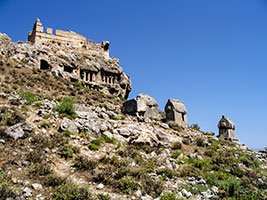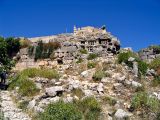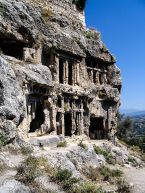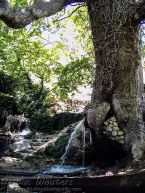Tlos was one of the most ancient and important cities in ancient Lycia.
History
Hittite records dating back to the 14th century BCE, already mention Tlos as Dalawa in the Lukka lands. Additional testimony to its old age was the discovery of a bronze axe dating from the 2nd millennium BCE.
Tlos was one of the six principal cities that constituted the Lycian Federation, the others being Xanthos, Patara, Olympos, Myra, and Pinara. The city was fortunate that it could benefit from donations by the wealthy benefactors Opramoas of Rhodiapolis and Licinnius Langurd of Oenoanda. The city was still inhabited during the Byzantine period and is one of the few ancient towns in the area which was able to maintain its status until the 19th century. Tlos was rediscovered in 1838 by the British explorer Charles Fellows.
Sights & Photos of Tlos
Tlos has a dramatic setting high above the Xanthos valley, dominated by its acropolis on a rocky promontory. The walls that surround the acropolis as well as the fortress on top of it date from the Ottoman period. The acropolis served as a stronghold for several derebeys (valley lords) and brigands, of which the 19th century Kanlı Ali Ağa (Bloody Chief Ali) was certainly the most notorious.
From the top of the acropolis of Tlos, there is a spectacular view over the Xanthos valley. Beneath the top of the acropolis is the necropolis with some Lycian sarcophagi and a vast number rock-cut house-type Lycian tombs, among which the famous, but difficult to reach, Tomb of Bellerophon.
At the southernmost part of the archaeological site are the remains of the public baths with two complete rooms one of which contains an apse with seven windows, called Yedi Kapı (Seven Gates) by the locals. A bit further down the road stands the well-preserved Roman amphitheatre dating from the second century BC, with still 34 rows of seats remaining. The theatre was built by Opramoas for the sum of 60,000 denars.
https://www.turkeyphotoguide.com/tlos?tmpl=component&print=1&layout=default#sigProIdb4cda28c77
Travel Information & Travel Tips
The archaeological site of Tlos is situated close to the modern village of Asar Kale (Asarkale, Kale Asar).
Further down the road from the theatre is the village Yakaköy (Yaka village) with several trout restaurants. Yaka Park, an old watermill, is definitely the most interesting. A special attraction here is the bar, where your drinks are kept chilled in a sluice through which your potential dinner is swimming. Turks are fascinated by running water in idyllic settings and enjoy its refreshing and relaxing qualities.
A visit to Tlos is easily combined as a day-trip with a visit to Kadyanda and Kayaköy as a one-day excursion from Fethiye.

























